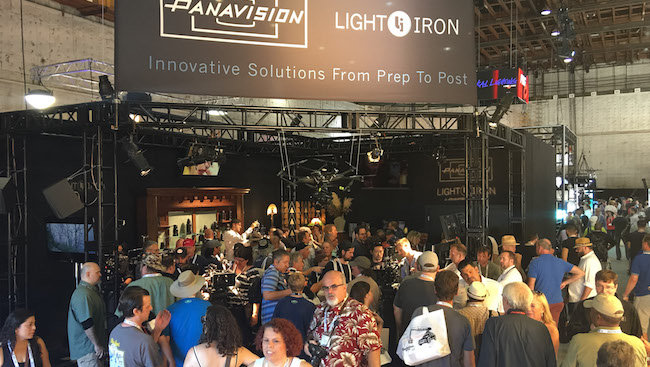
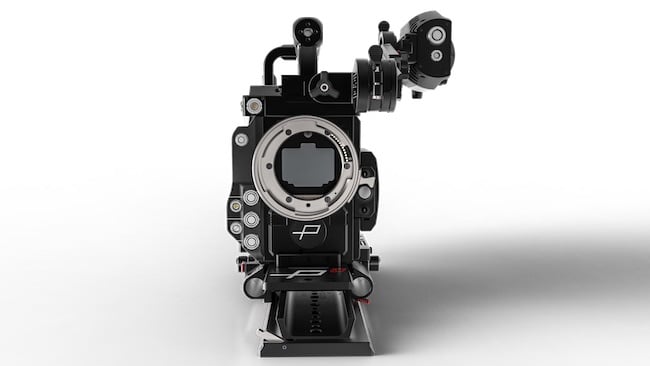 The Millennium DXL: “the most advanced digital cinema camera ever made”
The Millennium DXL: “the most advanced digital cinema camera ever made”
It was the camera that broke Cine Gear 2016. Michael Cioni, President of Light Iron and Product Director of the Panavision Millennium DXL, talks to Matt Aindow about the DNA of one of the most spectacular camera launches of 2016.
In 2015, when I last spoke to Michael Cioni, the Product Director of the Panavision Millennium DXL, Light Iron had just joined forces with Panavision.
So, was the Millennium DXL project on the cards from the very beginning? Michael sees it as an inevitable evolution.
“It started with the acquisition of Light Iron. If you actually look back over the last 18 months, people will start to see the DNA of this camera coming through. Light Iron is not only a colour science company it’s also a post production workflow company; buying a workflow company can really help in developing a camera ecosystem.”
Once Light Iron re-engineered their OUTPOST Mobile Post System to the Panavised OUTPOST (capable of doing a massive amount of fast rendering, storage and development) it became clear that a camera with a really powerful processing engine behind it was on the cards.
Cioni continues. “We started pushing and building up our Live Play dailies software (currently at Live Play 4) our latest cloud-based collaboration tools, so that’s part of workflow and you can connect the dots that this camera is going to have some integration with cloud-based components, etc. And then last Cine Gear (2015), exactly one year ago, we debuted the Weapon 8K sensor. We showed it on an 98’’ 8K monitor made by BOE (who made one of the first 8K monitors) because we wanted to see how the community reacted to 8K pictures and how Panavision’s newest set of large format Primo 70 lenses matched up with it. So that was all part of what we hoped would all come together.”
The Millennium DXL, in terms of resolution, pixel pitch, lensing, ergonomics, accessories and electronics, is the most advanced digital cinema camera ever made. It’s a super computer with modular accessories and superior RED electronics. But that’s not the only reason this camera is so special.
Creative control back in the hands of the cinematographer
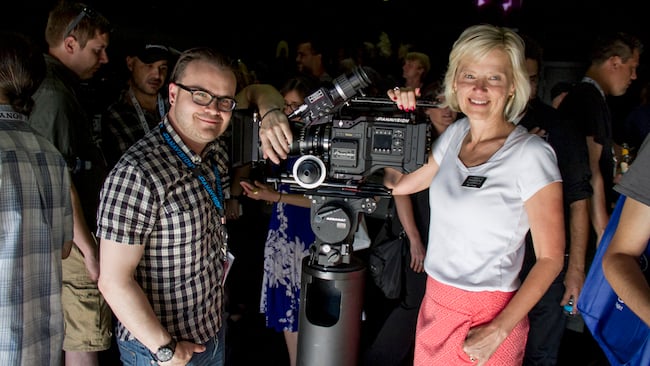
Light Iron President Michael Cioni and Panavision CEO Kim Snyder at Cine Gear Expo 2016
Who is controlling the image in the age of digital cinematography? At the recent international cinematography summit held at the ASC Clubhouse, lensers from around the world described a state of ‘crisis’. Guillermo Navarro warned us that “Technology has enabled ignorance — everyone's an expert… We have to convey that we are artists. We are not technicians.”
The finger was well and truly wagged at new tools and cameras. But editors performing an unsupervised re-grade got a special mention. ‘That’s not what we shot!’ is the often heard cry from DPs.
So the Panavision DXL couldn’t be more prescient. Meanwhile, whilst everyone's been talking about currently what is, Michael Cioni is really excited about what DXL is going to become.
Over the next 18 months, Panavision will announce upcoming phases of the DXL project. Cioni elaborates: “Where we are going with this camera is far more exciting than where we are starting! What you see today is literally the tip of the iceberg. I can tell you that the roadmap that we’ve outlined creates more cinematographer creative control. So even though today it’s already the most advanced cinema camera on the market, we are taking it in a technical and creative direction [Cioni previously coined the phrase “technative”].
“Of course we needed an incredibly powerful set of electronics to start with, which is what RED gave us, and that allows us to migrate into a creative direction. You're going to see how this camera has the ability to make pictures as unique as your own fingerprints. That's where the DXL project is going and that is something no one has ever done before.”
I think we nearly broke our Cine Gear booth!
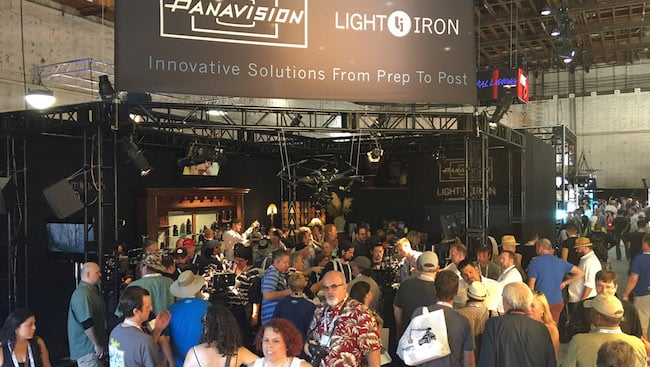
At the recent Cine Gear expo in LA, the Panavision booth was swamped. The theme running throughout the booth was ‘speakeasy’ so in a small set with a Lens Bar on the back wall with glass instead of liquor bottles, the DXL was set up so that you could put any lens from Panavision’s large-format fleet on to the camera and see how it looked on a real-world set.
Cioni is justifiably delighted about the attention the DXL received.
“Well, I think we nearly broke our Cine Gear booth! We are so thrilled and we feel so thankful that so many people came to visit. The Panavision booth was not just mobbed… It was a social event. I think that was probably the most interesting and wonderful thing that happened that we could never have predicted. People hung-out, they talked, they didn’t just bounce into each other or just talk to Panavision people, they talked to each other, they laughed, they had fun, we enjoyed each other.
“That's really what it’s about. Cinema is a community. Internationally it’s a community of people that look out for each other, care about each other and want to strive for the best pictures. Competition is fun but at the heart of all this is people. This is a people business, and people deserve to have options. The people from Cine Gear were helpful and it’s a wonderful show, probably one of the best shows in the United States.”
For readers this side of the pond, when can we expect to see the DXL in the UK? Very soon Cioni assures us, but don’t look for any DXL footage on the web just yet. “The members of the community who can appreciate this sensor need to see it properly projected.”
Panavision London has a 4K theatre where DPs and colourists (in the UK at least) will in all likelihood be able to first experience the pictures. In terms of seeing the prototype camera, Panavision will be making announcements shortly for booths at major European shows.
Panavised Weapon Cameras
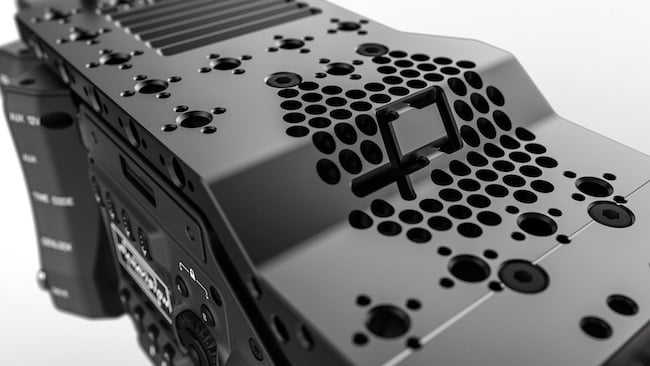
Colleagues on the CML forum wondered about plans to build a DXL Mini suitable for drone/gimbal work. Panavision are there way ahead of you, although it wouldn’t actually be a DXL Mini. Instead Panavised Weapon Cameras will have the same image block as the DXL.
“Luckily we don't have to make a Mini! RED already makes that for everyone, and Panavision happens to own more than any other rental company,” says Cioni. “Panavised Weapon cameras will have the same imaging, including all those components (the glass, the optics, sensor and colour) so that when people rent a Weapon for use on a drone or gimbal it will match the DXL perfectly.”
I wonder what else could be inferred from this statement regarding the differences or similarities between the DXL and RED Weapon? RED built, in my opinion, the best camera for the greatest number of people. They serve a massive community by creating specialty versions of their camera that work for nearly every sector of the market. Panavision by stark contrast, serves a limited sector of the market. The colour science and the optical path - lenses, filters, sensors and colour – of the DXL are only designed for the few people that Panavision/Light Iron service. It’s specific.
Cioni argues: “We are not saying our colour is better, it’s just specific to a group of people that rent from Panavision at a very specific level. We know what those people tend to do in a DI, and what we're trying to do is put that Look a little bit earlier in the chain.”
Light Iron Colour
Never before has a colourist designed the colour science of a camera. That was the challenge for the Light Iron team. The colour science of a camera usually comes from a an engineering perspective and, in short, generally aims to replicate colours as they exist in nature. The specific look on the DXL is something that Light Iron Supervising Colourist, Ian Vertovec, engineered, based on thousands of hours of DI colour correction. As Cioni explains, “He is running the DXL colour science from a colourists’ chair. That’s different. What we are trying to do is leverage the experience he has to assemble or filter that down to what most DPs want in the camera. That’s the philosophy behind Light Iron Colour. It’s not something no one else can achieve with DI tools.”
Post is production
The partnership between Panavision, RED and Light Iron appears to be both a Hollywood and an American success story. What, if anything, does the DXL say about the state of American filmmaking ingenuity and technical expertise? Michael doesn’t see it from a nationalistic perspective.
“It is an American product, I suppose, but that doesn’t really matter. It’s a Panavision/RED/Light Iron product. We didn’t decide this based on the passports of who’s involved. I celebrate the German and the Japanese cameras. I support them. I love the Varicam, I love the Alexa. They’re great cameras. We evaluate the best tools available. Panavision's perspective on this is, when we looked at all the people out there, RED had the best electronics and the best sensor. They happen to be local and conveniently close, and that probably helps to speed things up…
“Everyone knows Panavision are the best at accessories and lenses and Light Iron are the best at workflow… people should be able to do the math and see how that does make sense because post is production, we believe that in our bones and if I was wrong, this camera wouldn't have any interest or impact on the community. But it does, because the community has responded to the fact that post is production, post matters and a post house can collaborate with the camera company and an electronics company and they can make something magnificent.”
8K Workflow
I was interested to hear how much processing power and storage speed are required to do the heavy lifting work with 8k. How do you throw that material around your edit or DI suite? Light Iron has engineered a way for people to work efficiently so that 8K isn’t going to become a hindrance.
In order to make the work flow, that’s where the dual recording ProRes 4K or 2K proxy comes in to play. Clever stuff. Many users will never need to use the 8K, or they might use the 8K for long-term archiving and just work off the 4K, or they can use the 2K to make all their dailies deliverables. Some people will use a combination of both formats, using the 4K for certain shots and then for the wide-shots or VFX plates they can go to the 8K. Flexibility and workflow options abound. The R3D material clocks in at about 1TB/h in 8K so it's actually pretty reasonable. Many would agree REDCODE is already the most efficient, high-quality codec on the market, and the last thing the world needs is a brand new codec to chase.
The world of cinema has always fought to distinguish its USP vs TV, often with gimmicks, but mostly by non-square aperture formats. With the uptake of UHD 16:9 and the new standards for pixel quality on the broadcast front, the lines are more blurred than ever. But Michael Cioni believes that one point of significance with the Millennium DXL may just reverse this challenge. From this moment, large-format is going to become the new normal for cinema. Everyone's going to start switching to large-format and you'll see ultra widescreen anamorphic and large-format becoming the new word on everyone's lips.
Remember, Panavision have sixty years of large-format glass experience. And since the 1980s, when many people moved to 35mm, most of it hasn't been used that often.
“We are now dusting off all this wonderful large-format glass series - Sphero 65, Ultra Panatars, System 65 – lenses that some people have never even heard of and they are making pictures on these sensors that are just remarkable. That's what cinematographers deserve,” says Cioni.
The more I investigate this, the more I begin to appreciate the mature thinking behind the RED, Panavision and Light Iron collaboration. It seems so obvious now. These three companies just hit the re-set button and laid in a new course for large-format cinematography and workflow from which we, as an industry and as consumers, will benefit in the years to follow.
As Michael Cioni generously concludes, “Now every one else knows what we’re doing they’ll want to build something better. And guess who wins in that? Everyone wins. Everyone wins when that happens.”
My sincere thanks to Michael Cioni and the Light Iron team, Christina Smith from RED UK and Geoff Boyle’s CML’rs Art Adams and Nick Morrison.
Tags: Production


Comments